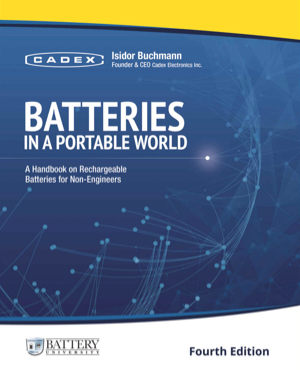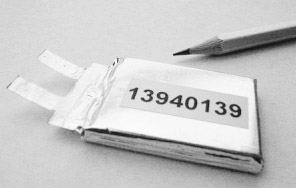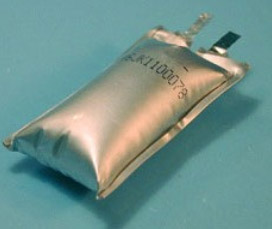| In 1995, Li-polymer surprised the battery world with a radical new design, the pouch cell. Rather than using a metallic cylinder and glass-to-metal electrical feed-through for insulation, conductive foil tabs welded to the electrode and sealed to the pouch carry the positive and negative terminals to the outside. Figure 1 illustrates such a pouch cell. | ||
| ||
| The pouch cell makes the most efficient use of space and achieves a 90 to 95 percent packaging efficiency, the highest among battery packs. Eliminating the metal enclosure reduces weight but the cell needs some alternative support in the battery compartment. The pouch pack finds applications in consumer, military, as well as automotive applications. No standardized pouch cells exist; each manufacturer builds the cells for a specific application. | ||
| Pouch packs are normally Li-polymer. The energy density can be lower and be less durable than Li-ion in the cylindrical package. Swelling as a result of gas generation during charge and discharge is a concern. Battery manufacturers insist that Li-ion batteries do not generate excess gases that can lead to swelling when properly used. Nevertheless, some swelling can occur and most is due to faulty manufacturing. The pressure from swelling can crack a battery cover open and in some cases break the display or electronic circuit. Manufacturers say that an inflated cell is safe. While this may be true, do not puncture a swollen cell in close proximity of fire or heat; the escaping gases can ignite. Figure 2 illustrates a pouch cell that has swelled. | ||
| ||
To prevent swelling, the manufacturer adds excess film to create a “gas bag” outside the cell. During the first charge, gases escape into the gasbag, which is then cut off and the pack is resealed as part of the finishing process. Gas buildup on subsequent charges is minimal; nevertheless, when designing the battery compartment for pouch cells, provision must be made to allow for some expansion. It is best not to stack pouch cells but to lay them flat side by side. The battery compartment must be made to protect the cell from mechanical stress and be free of sharp edges. | ||
Summary of Packaging Advantages and Disadvantages | ||
|

Comments
Looking for comments from the previous website?
Comments from the previous website are not compatible with our new commenting system but we have preserved them so our users can still reference and make use the information in them.


